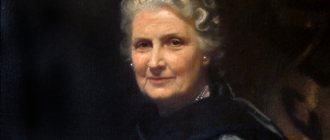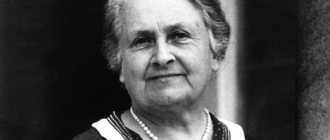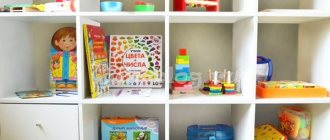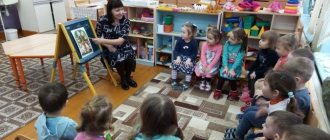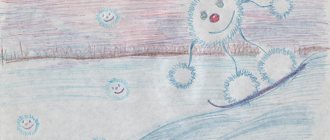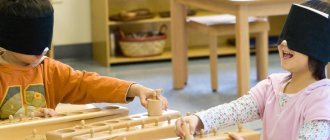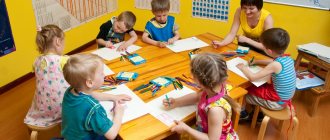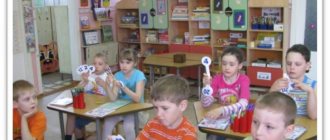The beginning of the twentieth century literally divided the history of mankind into before and after, because life underwent incredible changes and required new moral guidelines, approaches to education and upbringing, and the organization of work and leisure. It was a period of bold experiments and amazing discoveries. Despite all the social upheavals, people of the twentieth century became freer and more progressive, which means that upbringing and education had to change a lot, because kids had to grow up in a completely new world.
The observations and innovations of the Italian doctor Maria Montessori became a real breakthrough in pedagogy, since her approach simultaneously had both a good theoretical basis and brilliant results in practice. In this article we will try to highlight all the main features of Montessori education and discuss for which children classes using the M. Montessori method are best suited.
Basic Montessori Methods
To briefly outline the main ideas of the Maria Montessori method, it is important to first explain on what beliefs the approach is based:
1. The child develops following his natural interests and thanks to the experience independently gained on their basis,
2. Only a well-organized environment allows a child to fully realize his development potential,
3. An adult can be a guide and assistant, but cannot become the only full-fledged source of knowledge and skills for the development of a child,
It is these beliefs that determine the style of interaction between children and adults who have chosen the Montessori method for their children.
The approach is distinguished by a specially organized environment (didactic material freely accessible to the child), appropriate to the age of the children; the child’s leading position, his independence and free choice of activities; respectful and attentive attitude of adults to the individual needs of the baby.
Let's briefly formulate the basic principles of the Maria Montessori method:
1. Lack of a classroom system and free movement of the child in the classroom space,
2. The absence of a unified program and compulsory curriculum for all pupils, an individual approach to each child,
3. Classes using the M. Montessori method are held in a group of different ages,
4. Any Montessori session requires a prepared environment, ordered and varied materials for learning,
5. The adult follows the child’s interest, observes the children’s work and is very limited in their independent activities.
Now let's study in more detail the features of the Montessori method and start with what goals a Montessori teacher faces depending on the age of the students.
Matching games
Matching games are the most popular Montessori activities for ages 1 to 3. The main types are:
- Activities with colors - you can offer your child a cardboard circle with multi-colored sectors and clothespins of the same shades. The child must independently choose his own clothespin for each sector.
- The game can be combined with the help of mom. For example, invite your child to sort washed socks into pairs.
Sequence of stages of implementation of problem-based learning technology
This group of classes develops logic and attention.
Games with colors
Goals of lessons using the Montessori method by age
The approach provides education for children from birth to secondary school, while the focus of attention, and therefore the techniques used in a Montessori environment, depend on the age of the child. Below we offer a table that outlines the main goals of Montessori education for children at different age stages.
| Child's age | Goals of Montessori education | Basic techniques and formats |
| From birth to three years |
|
|
| From three to six years |
|
|
| From six to twelve years |
| A comprehensive study of the experience accumulated by humanity and more specialized classes devoted to the study of the universe, wildlife, humanity, language and the world of exact sciences |
| Twelve to fifteen years old |
| Unfortunately, the methodology was not developed by Maria Montessori herself, however, followers of the approach actively use group work, scientific discussions, individual educational plans and practical work for the personal and professional development of adolescents |
Even from this table it is clear that the development of a harmonious personality must certainly begin at a very early age, which is why Montessori teaching methods are used primarily in preschool institutions, because in the future Montessori graduates are much more adaptive and achieve better results in schools of a variety of approaches.
First of all, the essence of the Montessori method for children of all ages is education based on the individual strengths and interests of each child. Montessori education encourages children to explore the world around them and find their own place in this world.
DIY Montessori materials
The child grows very quickly, so he constantly needs more and more new play equipment. Of course, Montessori manuals can be purchased at any specialized store, but they are quite expensive, and it is much more interesting to make them yourself.
Mom will be able to save significant money, because such benefits are often made from waste materials, which are usually simply thrown into the trash.
Insert frames
So that the child can understand what geometric shapes are, remember the main shades, and learn the gradation of sizes, you can make simple inset frames.
To make it you will need to take:
- rigid or corrugated cardboard;
- a sheet of paper (whatman paper or a piece of paper from an ordinary album);
- colored or self-adhesive paper;
- beads or buttons;
- wire.
The algorithm for producing the manual is as follows:
- The cardboard needs to be cut into rectangles. Their number depends on the number of geometric shapes that the mother wants to introduce her child to. For a 1-2 year old baby, four basic shapes are enough: a circle, a square, a rectangle and a triangle.
- In a rectangular figure, it is necessary to cut out certain silhouettes (squares, triangles), and first cut out the largest one, then smaller ones and even smaller ones.
- The resulting inserts need to be covered with colored paper from the “obverse”. Figures of the same category (that is, all triangles) must be of different shades.
- All inserts must have a bead or button attached to the middle using a wire element. This is necessary to simplify the use of the manual.
- All that remains is to glue the finished frames to the base of whatman paper or album sheet.
That's it, the guide to studying geometric shapes and basic shades is ready. You can work with him starting from the age of one year.
Pyramid of pillows
The production of this developmental manual requires parents to have basic ability to use a sewing machine or a regular needle and thread.
This “pillow” pyramid is designed to teach a child to identify shades and navigate different sizes. In addition, the manual will help develop tactile sensations if you fill the pillows with a variety of materials.
Required components:
- fabric cuts of various textures and colors;
- duct tape;
- stuffing material: foam rubber, buckwheat, peas, any other cereal, onion peel, etc.
From one piece of textile you need to cut 2 squares with sides from 5 to 12 centimeters. Please note that one pillow will be sewn from two flaps of different shades. And the sides of adjacent pillows will be the same color. Let's look at an example.
At the base of the “cushion” pyramid there will be a roller with a side of 12 centimeters. We make its bottom green and its top blue. The edges of the next pillow will be 11 cm. We sew the lower part from blue fabric, the upper part, for example, from red.
Consequently, the third pillow will already have edges of 10 cm, and its bottom is made in red, but the top can be made to suit your taste. The sequence and logic of actions are clear.
Velcro must be sewn onto the front sides of the pillows, and a hard element of adhesive tape must be attached to one part, and a soft element to the other. This is necessary for the subsequent assembly of the pyramid, since the tape is a fastening element.
After this, the flaps for one pad are folded with the “obverse” sides and sewn, but on one side you need to leave a small hole, we will need it for stuffing (after filling, the open area will be sewn up).
The pad needs to be turned out and filled with stuffing. To fill the largest square, you need to use the heaviest material (for example, buckwheat) to give the assembled structure maximum stability.
Rough letters
To make these useful elements, you need to take:
- colored paper (blue and red);
- stencil images of letters;
- cardboard;
- glue stick;
- PVA glue;
- semolina.
To make a guide, you need to follow several important steps:
- On the sheets you need to use stencils to depict the silhouettes of the letters. Moreover, there will be consonants on blue paper, and vowels on red paper. An alternative is to print ready-made stencils on a printer.
- The next step is to glue the leaves to the cardboard. It should be as dense as possible, for example, from a shoe box. For gluing it is better to use a glue stick.
- Then the blanks need to be placed under the press, you should wait a little for the cardboard to dry thoroughly.
- After drying, the workpieces need to be cut into separate rectangles with letters. Silhouette letters are outlined with PVA glue and sprinkled with semolina. However, you don't need to use too much cereal.
- Excess semolina should be shaken off, and then the cards should be dried. They are attached to the cardboard by the corners using pins or buttons so that the rectangles do not become deformed.
- The final touch is the application of the second adhesive layer. It is needed so that the semolina does not crumble during exercise. We are waiting for the cards to dry completely.
Rough letters are used from 3 to 4 years of age. This manual is placed in the language zone and used for classes to prepare for reading and writing.
With the help of rough blanks, associations of sounds and letters are developed, their names are memorized, and fine motor skills are improved. In addition, the child learns to trace letters correctly, as in subsequent writing.
Sensory bags
To make this Montessori teaching material, you need to stock up on:
- natural textiles (satin cuts);
- various cereals (buckwheat, millet, rice or semolina), beans and peas;
- curly pasta.
Below is a step-by-step algorithm for creating sensory bags for little children:
- Initially, fabric blanks for bags are cut out; the size can be any, but the proportions must be observed. The length of the flap corresponds to two widths of the product, you also need to add a centimeter to the seams.
- The material is folded in half with the right side inward, the sides are completely stitched and half of the top part is stitched. You also need to secure the threads on both sides of the line.
- Buckwheat or other cereal filling must first be calcined in the oven for 20 minutes or in the microwave for 3 minutes. This is done to avoid the development of bugs in the future.
- The bags are turned inside out and ironed. Then filler is poured into them; it is important to ensure that the weight of all benefits is the same. Also, you should not put several types of cereals into a bag at once.
- The final touch is stitching the top part to the end. All excess protruding threads are cut off and given to the child for fun play and development.
You can also create bags in the shape of a happy caterpillar. To do this, you need to cut off the required length from the tights, add, for example, buckwheat, and tie a knot to make a ball that is dense to the touch.
Then another type of cereal is poured in and the knot is tied again. This step is repeated with each type of filler. After which the tail of the caterpillar is stitched and the resulting toy is beautifully decorated. For example, you can take beads for the eyes, but they need to be sewn tightly.
Such a benefit is suitable even for the smallest child. It perfectly develops sensory sensations, fine motor skills, and attentiveness. In addition, the use of sensory bags allows you to effectively develop auditory perception.
Mobile
Maria Montessori's method also involves the use of pendants for newborn babies and older children. Such devices differ from industrial versions in the absence of musical accompaniment and rapid rotation of elements.
Most often, the forms are taken abstract, rotation occurs due to the air in the room. Such a leisurely movement will definitely please the child, who will begin to track the movement of the toy, focusing his gaze. A popular suspension model is the hex mobile. To make it you need:
- light wooden stick;
- 3 pieces of cardboard in basic shades: yellow, red and blue;
- glue;
- ribbon.
To make this developmental aid for babies, you need to perform several steps:
- A hexagon pattern is drawn on cardboard. You can also make a printout on colored paper and stick it on cardboard. Dry thoroughly.
- The folds are processed using scissors and a ruler to avoid breaks and unnecessary bends.
- Then the hexagonal pattern is cut out and assembled into a shape, glued at the joints. This is repeated 3 times.
- The ribbons are secured in one of the seams of the product and tied with the other end in a wooden stick. It is important that it is free of roughness and burrs.
- The finished mobile is fixed at a distance of 25 - 30 centimeters above the child.
A similar benefit is offered to children from 3 months of age. It will teach your child to focus his eyes on rotating objects, track them, perceive their shades and shape.
Touch mat
Such a coating, of course, can be purchased in a store, but you can also make it yourself. Remnants of old clothes and various accessories will do:
- textile scraps;
- hooks;
- buttons;
- lightning;
- Velcro;
- buttons;
- other fasteners.
Initially, you need to sew a blank for the sensory mat; the size and shape can be any. You can fill the base with padding polyester. If you don’t want to mess around, experienced mothers advise taking an old flannelette blanket.
Further creation of the rug will depend only on mother’s imagination. Touch coating usually combines textiles of different textures, patch pockets with fasteners, sewn-in beepers, balls with various fillings, etc.
This developmental material promotes children's sensory development from 8 months of age. The child will also develop fine motor skills and learn to use different fasteners, which is essential for self-care skills.
Busyboard
This is the modern name for Montessori stands, which are boards for development, to which everything is attached that is usually strictly forbidden for a child to touch. With the help of boards, children safely get acquainted with household objects.
Making a busy board will require a little imagination from parents and the following equipment:
- chipboard board;
- self-tapping rods;
- adhesive;
- locks with keys, chains;
- switches;
- sockets;
- disk element from an old phone;
- window latches;
- fasteners;
- buttons;
- lacing, etc.
Making a development board is quite simple. On a sheet of chipboard you need to draw a diagram of the future business board; you can even act in accordance with a certain plot.
The parent lays out the parts, and then screws them very tightly to the board using self-tapping screws. The strength of the fastening is very important, since the child will try to tear off the element of the aid he likes.
For more information on how to make a busy board with your own hands and what equipment you will need for this, read the article by the children's doctor.
This educational material is suitable for children from one year to 6 years old. A baby who is already sitting and walking will be able to independently study objects and interact with them: open and close locks and fasteners, use sockets, and work with lacing.
This homemade bodyboard develops fine motor skills, attentiveness, and perseverance. The child learns to solve everyday problems and also satisfies his interest in everyday objects. He especially likes the variety of elements.
Multi-colored hedgehogs
This is the simplest teaching material possible. Mom cuts out silhouettes of a hedgehog or any other shapes from bright cardboard. You can also use regular corrugated cardboard decorated with self-adhesive film.
The most common option is a hedgehog, which can be completed with “needles” using trailers. Parents also make a sun with clothespin rays, various animals and people out of cardboard. Additionally, these figures are painted with felt-tip pens or paints.
If you take the clothespins to match the color of the outline, the child will not only develop fine motor skills, but also learn the basic shades. For example, yellow clothespins are suitable for the sun, green ones for a Christmas tree, and blue ones for a blue cloud.
Montessori method - for which children is this approach suitable?
Surprisingly, we often meet parents who are convinced that Montessori teaching methods are only suitable for gifted and “naturally” motivated children. Parents feel that if their son or daughter is not forced to study, they will simply lie on the couch all day.
In fact, it is always worth remembering that children’s curiosity and desire to explore the world are an innate quality of absolutely any child. The described passivity is most often caused by external factors: an unsuitable environment and an incorrectly organized daily routine, incorrect behavior of adults, and poor health of the child.
Despite the fact that all Montessori techniques involve the child’s free choice and almost unlimited movement around the classroom, even the most “uncontrollable” and “difficult” children eventually successfully integrate into the process.
However, if you think that at first it will be difficult for your baby in group classes using the Montessori method or you are worried about some of the child’s health, all branches of our club offer individual lessons so that your baby has additional adult attention for easier adaptation to a new environment.
Montessori games for early development: small objects
Transferring small objects (coins, beads, pebbles) from one vessel to another using tongs or a spatula is a rather difficult task for small fingers. But it develops the child’s fine motor skills well.
How to develop your child's self-confidence and strengthen his self-esteem
Beans, buckwheat, rice and other cereals are also good for playing with small objects.
Sensory development
Montessori kindergarten - what to expect from classes using the well-known method
The Montessori method is in demand both at school and in preschool institutions. However, in Moscow, most often, classes using the Maria Montessori method are designed for children up to 6-7 years old, after which they successfully transfer to both specialized Montessori schools and general education institutions. Taking into account this peculiarity of Moscow education, we have developed both a program exclusively based on the Montessori method, and groups where Montessori teaching methods and its basic principles are organically combined with more traditional formats of classes for children, as well as visits to a speech therapist and other specialists.
The environment of Montessori kindergartens stimulates children's cognitive activity. All Montessori classes are divided into zones: practical life, sensory, language, mathematics, space (the world around us), creativity. Each zone is filled with a variety of educational objects and didactic games, by interacting with which the child independently studies the properties and functions of things and learns new things.
In a Montessori kindergarten there is always a lot of space and educational materials, children always have the opportunity to choose an activity to their liking, and kindergarten teachers who have undergone special training in the Montessori method only help children make independent discoveries.
A pleasant bonus for parents who have chosen a kindergarten using the Montessori method will also be the availability of regular consultations for parents, at which teachers and child psychologists explain in detail the objectives of the method, share the successes of their students, and also give recommendations on education using the Montessori method. Houses.
Sent for sorting
Games focused on the sorting principle are aimed at developing visual skills and help train other organs. As a game activity you can offer:
- Sorting items from 2 to 5 years old. It can be both in shape and color. The lesson develops attentiveness and logic. For the activity you need to take several sets of objects according to size, shape and color. Playing with buttons has a good effect on development. You need to take a large number of buttons, in which there will be five or six identical ones. Mix all the buttons in a bowl, then show your child which type to choose.
- An excellent activity for sensory development is wooden cubes of various sizes. You can buy cubes that are inserted into each other, like a nesting doll.
- A pyramid would be a good activity for children aged two years and older. It can be of any type, but the principle is the same. Such a toy should have one rod and a set of elements. The child's task is to find identical shapes, for example, circles.
- You can choose simple puzzles as a sorting game. In the Montessori method, wooden ones with beautiful pictures are selected. For children under four years old, you should choose puzzles in which each element has a handle to make it easy to hold. It is recommended to avoid cardboard frames.
Pyramid game
conclusions
Education according to the Maria Montessori method is qualitatively different from traditional approaches: an adult does not teach lessons and does not require them to put their hands on the desk and listen carefully, children have the opportunity and time to learn what is interesting to them, and a specially organized environment ensures that “interesting” “was always “useful.” Thanks to these conditions, the method has received international recognition, graduates of Montessori gardens consistently demonstrate interest in learning, developed self-control skills and successfully master the school curriculum, and parents are proud of their talented, independent and truly happy children.
